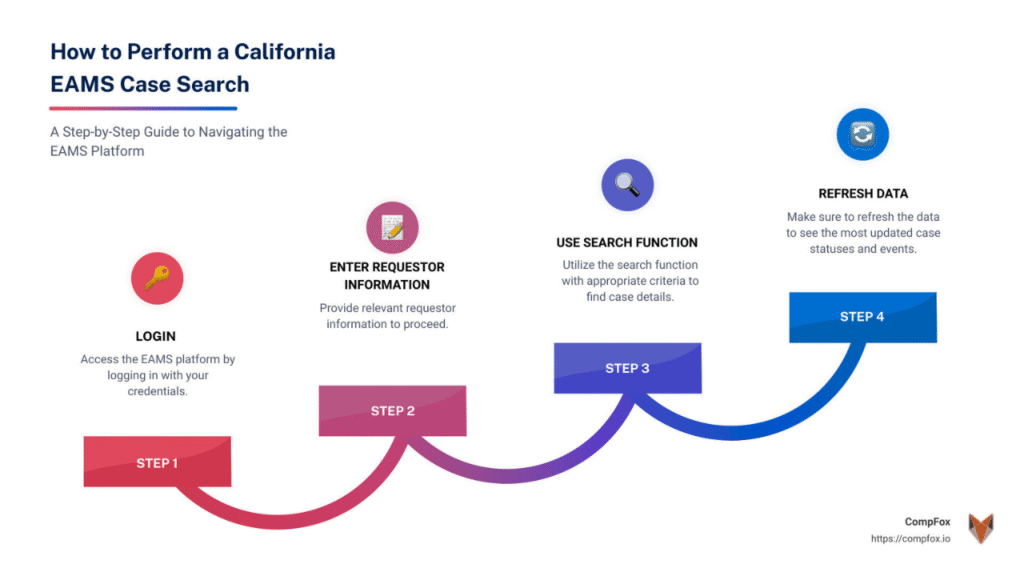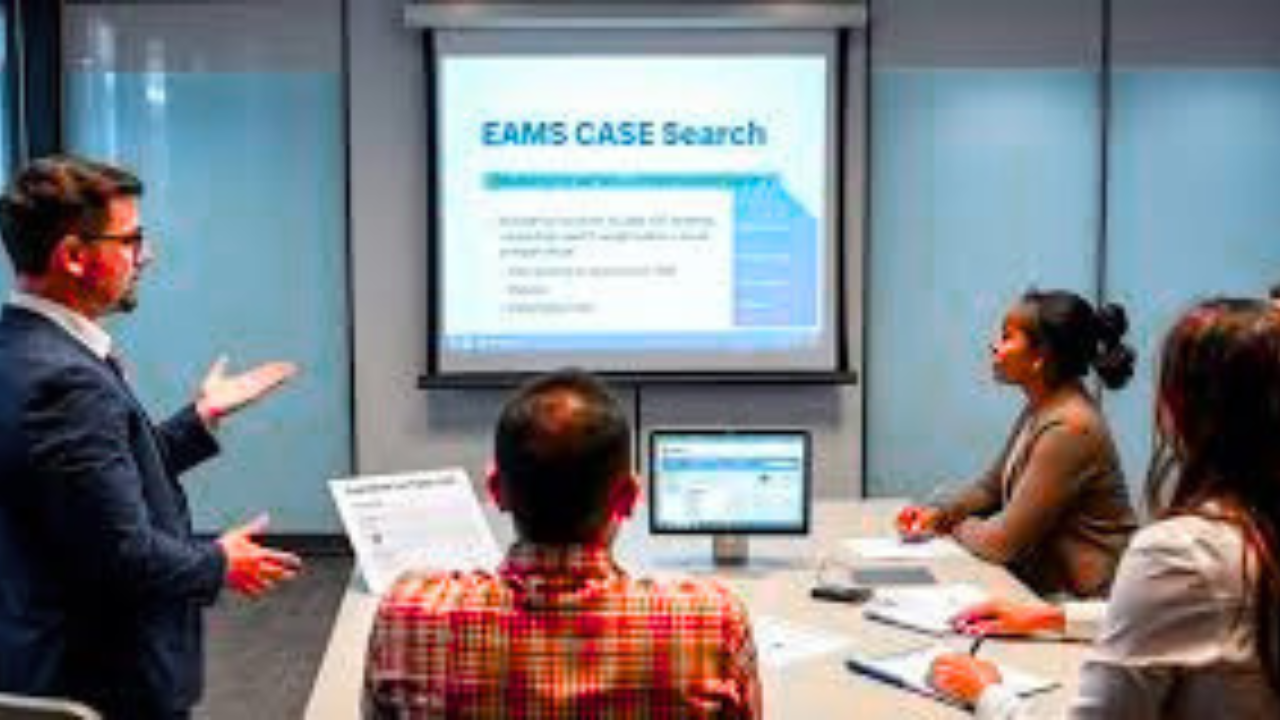California processes over 200,000 workers’ compensation claims annually through its Electronic Adjudication Management System. Each case search request connects injured workers, attorneys, and employers to vital information that determines claim outcomes. This digital platform revolutionised how compensation cases move through California’s legal system.
The answer lies in mastering EAMS search case functionality, which provides instant access to both active and archived case files across the state’s workers’ compensation database.
This comprehensive guide reveals proven search techniques that legal professionals and injured workers use daily. You’ll learn step-by-step methods to locate any case within seconds, regardless of how limited your initial information might be.
Table of Contents
EAMS Case Search for California Workers and Businesses
The Electronic Adjudication Management System serves as California’s backbone for workers’ compensation cases. Every single workplace injury claim filed in EAMS Case Search California flows through this digital case management platform.
What is EAMS?
EAMS stands for Electronic Adjudication Management System, launched in August 2008 by California’s Division of Workers’ Compensation. This electronic case system replaced outdated paper-based filing methods that caused delays and confusion. Before EAMS, finding case information took weeks. Now, an EAMS case search delivers results instantly.
The system handles approximately 250,000 new cases annually, making it one of the largest legal case tracking platforms in the United States. Every injured worker, employer, and attorney depends on this system for accurate case information retrieval. The California legal system relies on EAMS case search to maintain fairness and efficiency in dispute resolution.
Workers can access hearing schedules, medical reports, and settlement updates, enabling employers to track claim status and manage multiple cases. The EAMS case information search system processes cases from initial injury reports to final settlements, creating a permanent record of each worker’s compensation history. This comprehensive database supports medical treatment decisions, return-to-work planning, and legal proceedings.
| EAMS Statistics | Numbers |
| Launch Year | 2008 |
| Annual New Cases | 250,000 |
| Total Cases in Database | Over 4 million |
| Daily Active Users | 15,000+ |
Digital Case Management and the EAMS System Explained
Digital case management transformed how California handles workers’ compensation claims. Traditional paper files created bottlenecks that delayed medical treatment and wage replacement benefits for injured workers.
Modern Electronic Case System Benefits
The electronic case system eliminates physical storage limitations and geographical barriers. Attorneys in Los Angeles can instantly access cases filed in San Francisco without requesting file transfers. Judges review documents from any location, speeding up the adjudication process.
Ca Eams case search Insurance companies are enhancing transparency by providing workers with real-time updates, thereby reducing disputes and improving communication between them and employers.
Case EAMS search workers can submit specific documents electronically, reducing fraud and ensuring authenticity. The system operates 24/7, allowing professionals to submit documents outside business hours. Automated reminders prevent missed deadlines and maintain audit trails for accountability. Search functionality allows users to locate specific information quickly, protecting both workers and employers from disputes over case handling.
Integration with medical providers streamlines injury claims processing. Doctors submit reports directly through secure portals, eliminating mail delays. Insurance companies receive automatic notifications when new medical information becomes available, accelerating claim decisions.
Step-by-Step Guide to Using the EAMS Case Search Tool

Performing an effective EAMS case search requires understanding the system’s search parameters and login requirements. Success depends on using the right search criteria and following proper access protocols.
Login and Access Requirements
First, visit the Division of Workers’ Compensation website at dwc.ca.gov. Click the “EAMS Case Search” link located in the public information section. New users must register by providing contact information and agreeing to confidentiality terms.
Returning users simply enter their username and password to access the search portal. The system requires users to identify themselves and state their reason for accessing case information. This process complies with Labour Code Section 138.7 privacy requirements.
Before searching, users must confirm they will not share obtained information with unauthorised persons. Violation of this agreement can result in legal penalties and permanent access suspension.
Search Criteria Options
The EAMS case search tool accepts multiple search parameters for maximum flexibility. Case numbers provide the most direct path to specific information when available. Most case numbers begin with “ADJ” followed by seven digits (example: ADJ1234567).
Injured worker names require both first and last names for accurate results. Employer names should match exactly as filed in the original claim. Partial matches often return multiple results, requiring additional filtering.
Date ranges help narrow searches when dealing with common names or large employers. Hearing dates, injury dates, and filing dates all serve as effective filters. Judge assignments and case types provide additional search refinement options.
Advanced users combine multiple criteria to locate cases quickly. For example, searching by employer name and injury date range typically yields precise results. Always start with specific information and broaden searches if initial attempts fail.
Example Search Process:
CA EAMS case search uses a search criterion to locate a case, focusing on the case number, to ensure accurate results, as the system updates daily, reflecting the latest case details.
- Enter case number ADJ2345678
- If unsuccessful, try the injured worker’s full name
- Add the employer name for better accuracy
- Include injury date range if known
- Review all returned results carefully
| Search Type | Description | Example |
| Case Number | Unique case ID starting with ADJ | ADJ1234567 |
| Injured Worker Name | Full first and last name of the injured | John Smith |
| Employer Name | Name of the employer involved in the case | ABC Manufacturing |
| Hearing Date | Date of scheduled hearing | 09/15/2025 |
| Case Type | Type of hearing or legal proceeding | Mandatory Settlement |
What Information Can You Find Using EAMS Case Search

An EAMS case search provides comprehensive case information retrieval covering all aspects of workers’ compensation claims. The system displays both current and historical data for complete case understanding.
Case Details and Participant Information
Basic case information includes the case number, injury date, employer name, and assigned judge. Current case status shows whether the claim is active, settled, or archived. Injury descriptions detail the type and severity of workplace accidents.
All case participants appear with their roles clearly identified. Injured workers, employers, insurance companies, and attorneys are listed with contact information. Medical providers and vocational rehabilitation specialists also appear when involved in cases.
Address information remains available for business entities while protecting injured workers’ residential addresses. Attorney contact details help facilitate communication between parties. Insurance company information assists with claim coordination and settlement discussions.
Makes Workers’ Compensation Easier to Handle
The digital case management approach simplifies complex legal case tracking for all participants. Workers no longer wait weeks for case updates or hearing schedules. Employers can monitor multiple claims efficiently through a single portal access.
Hearing schedules appear with complete details, including dates, times, locations, and assigned judges. Document filing deadlines help prevent missed submissions that could harm cases. Settlement conferences and mandatory settlement conferences are clearly marked with preparation requirements.
Medical treatment authorisation status updates help injured workers plan their care. Return-to-work dates and disability ratings assist with employment planning. Benefit payment information keeps workers informed about wage replacement schedules.
| Available Information | Details Provided |
| Case Status | Active, Settled, Archived |
| Hearing Dates | Time, Location, Judge |
| Participants | Names, Roles, Contact Info |
| Documents | Filing Dates, Types |
| Benefits | Payment Status, Amounts |
Insurance adjusters, employers, and attorneys utilise integrated reporting to track claim expenses, reserve amounts, return-to-work progress, accommodation needs, and case timelines for effective representation.
Easy Legal Case Tracking and Data Access with EAMS
The EAMS platform provides sophisticated legal case tracking capabilities that support the entire adjudication process. Professional users depend on these tools for effective case management and client representation.
Dispute Resolution Through Digital Systems
Settlement proceedings have been streamlined, allowing for efficient scheduling and resolution of disputes, reducing costs and delays.
Judge assignments appear immediately when cases require formal hearings. Continuance requests process faster through electronic filing systems. Evidence submission follows digital protocols that ensure proper authentication and chain of custody.
The EAMS interface facilitates the appeal process, requiring the submission of required attachments and tracking of status throughout the appeal process.
Privacy and Data Rules to Know in the EAMS System
California Labour Code Section 138.7 governs all case information retrieval activities within EAMS. Personal privacy protection limits access to sensitive information like home addresses and social security numbers. Business information remains publicly accessible to maintain transparency in the workers’ compensation system.
Researchers and workers are utilising aggregate data from insurance companies and medical providers to study cases, while employers, attorneys, and other stakeholders are authorised to access the information.
Confidentiality agreements bind all system users to protect obtained information from unauthorised disclosure. Penalties for violations include monetary fines and permanent system access suspension. Audit logs track all access attempts and information downloads for security monitoring.
Data retention policies maintain case information for statutory periods required by California law. Archive systems preserve closed cases while keeping active cases readily accessible. Backup procedures ensure information remains available even during system maintenance or technical issues.
“The EAMS case search has transformed how we manage workers’ compensation claims. It saves time and helps everyone stay informed.”
California Workers’ Compensation Attorney
You Might Also Like: Noisecloud Bright Path with Positive Impact on Sound Data System
Industries & Professionals That Rely on EAMS Case Search Daily
Multiple industries depend on EAMS case search functionality to manage their workers’ compensation responsibilities effectively. Construction companies lead in system usage due to high injury rates and complex subcontractor relationships.
Professional User Categories
Medical searches are conducted daily to monitor and manage injured workers, ensuring they receive appropriate medical care and support.
Medical providers, vocational rehabilitation counsellors, and court reporters work together to verify treatment authorisation, review work restrictions, develop return-to-work plans, and maintain official case records.
Labour law administration professionals use the system for compliance monitoring and regulatory enforcement. Safety inspectors review injury patterns to identify workplace hazards. Union representatives advocate for injured members using comprehensive case data.
Third-party administrators manage claims for multiple employers through centralised case tracking. Self-insured employers maintain direct oversight of their workers’ compensation programmes. Government agencies monitor system performance and injured worker outcomes.
Healthcare networks coordinate care among multiple providers treating the same injured worker. Pharmaceutical companies track medication authorisation and usage patterns. Durable medical equipment suppliers verify authorisation for assistive devices and mobility aids.
Daily Usage Statistics
The system processes over 50,000 searches daily from approximately 15,000 active users. Peak usage occurs between 9 AM and 11 AM when attorneys and adjusters begin their workday. Monday mornings generate the highest search volume as users catch up on weekend case developments.
Mobile access accounts for approximately 30% of all searches, as users need information while travelling between hearings and client meetings. After-hours usage remains significant as busy professionals access the system outside normal business hours.
“EAMS has become an essential tool in workers’ compensation. It helps professionals across industries stay updated and make informed decisions quickly.”
Claims Administrator, California
Tips for Smooth Claims Processing in EAMS Case Search
Successful injury claims processing requires the strategic use of EAMS search capabilities and understanding system limitations. Timing your searches and organising results significantly improves efficiency.
Faster Digital Case Management Tools
Bookmark frequently accessed cases to avoid repeated searches for active files. Use multiple browser tabs to compare information across related cases efficiently. Download important documents immediately to avoid access issues during system maintenance.
Schedule regular search updates for active cases to catch new developments quickly. Set up email alerts when available to receive automatic notifications about case changes. Maintain offline copies of critical documents in case internet access becomes unavailable.
Master advanced search techniques by combining multiple criteria for precise results. Learn keyboard shortcuts to speed up navigation through search results. Understand system refresh schedules to know when new information becomes available.
Quick Search Tips
Use case numbers for quick access, use full names and employer details if not available, and narrow your search with hearing dates or event filters.
• Always start with the most specific information available.
• Use exact spelling for names and employer details.
• Include injury date ranges when searching common names.
• Save successful search criteria for future use.
• Clear browser cache if searches return unexpected results
Document organisation in management helps track important deadlines, ensuring proper attention to hearing dates and filing deadlines, while maintaining contact management systems for participant information.
The Division of Workers’ Compensation provides technical training and support to enhance search efficiency and accuracy, ensuring smooth operations and addressing any technical issues.
Regular password updates maintain account security and prevent unauthorised access. Two-factor authentication adds extra security layers for sensitive case information. Log-out procedures protect confidential information on shared computers.
“Using EAMS for injury claims processing saves valuable time and reduces errors, making it easier to focus on resolving the case.”
Workers’ Compensation Attorney
Bringing It Together with EAMS Case Search Results
Mastering EAMS case search techniques provides significant advantages in California’s workers’ compensation system. Reliable results depend on understanding search parameters, privacy requirements, and system capabilities.
Efficient case management supports faster resolution for injured workers, regardless of geographic location, ensuring equal access to justice and reducing administrative costs in the legal system.
EAMS employs systematic performance monitoring through tracking and monitoring, enhancing compliance and identifying system improvements, thereby enhancing the efficiency and effectiveness of its user-friendly system.
Unnecessary treatment strategies can be prevented through detailed tracking, ensuring that the system is used effectively and efficiently, thereby reducing unnecessary costs and promoting cost containment.
Future system enhancements will expand mobile access and integrate artificial intelligence for improved search suggestions. User feedback drives continuous improvements in interface design and functionality. Training programmes ensure all stakeholders can maximise system benefits.
EAMS success relies on learning effective techniques and staying updated with system updates, which enhance efficiency and reduce search time, while networking offers valuable tips and troubleshooting assistance.
Frequently Asked Questions
1: How often does EAMS update case information?
The system updates nightly, so information is typically one day behind real-time events. Emergency updates may occur more frequently for urgent situations.
2: Can I search for cases without knowing the exact case number?
Yes, you can do an EAMS case search using injured worker names, employer names, or date ranges. The system provides fuzzy matching for approximate spellings.
3: What happens if I forget my EAMS login credentials?
Contact the Division of Workers’ Compensation help desk for password reset assistance. You’ll need to verify your identity before receiving new credentials.
4: How long are case records maintained in EAMS?
Records remain accessible indefinitely for research and appeals purposes. Archived cases maintain the same information as active cases.
5: Can I access EAMS from mobile devices?
Yes, the EAMS case search system works on smartphones and tablets through web browsers. Mobile access provides full search functionality with responsive design.

